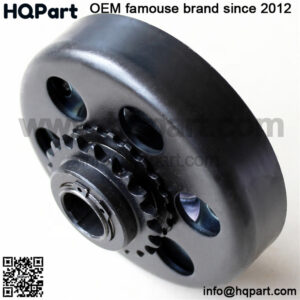Till now we have learnt how clutch works its parts and about slipper clutch. If you missed it, you can read that quick story here. Now we look at another type of clutch – the centrifugal clutch.
A centrifugal clutch uses centrifugal force for engagement and disengagement of clutch to drive shaft. Centrifugal clutch is used in automatic transmission. The centrifugal clutch is often used in mopeds, mini bikes, automatic scooter, lawnmowers, go-carting etc.
You can find its application on Honda Activa, Dio, Hero Pleasure, now discontinued TVS Jive, etc. Before we proceed to understand centrifugal clutch, let us know what centrifugal force is…
Centrifugal Force:
To understand centrifugal force, imagine yourself holding a spring which is attached to a ball. Now you are rotating the ball in circular mode as shown in the picture. Now there are two types of forces that come into the picture here – first one is centripetal force which is forcing the ball to move in your direction. As per Newton’s motion law – for every action there is a reaction; so another centrifugal force comes into the picture which forces the spring to move in the opposite direction.
If the force is too large the spring will break and the ball will fly off in a straight line tangent to the circular path. Take another example of passengers in the local bus when the bus turns right the passenger move in the other (left) direction. This is centrifugal force.
In the normal type of centrifugal clutch the clutch basket plays the role of hub as well as the basket. The inner teeth of the basket are connected to the engine crankshaft while the outer teeth are connected with the shaft, chain or belt. Under this basket friction pads or shoes are placed.
These clutch friction pads or shoes connect to various extension springs on the center shaft. These springs are fitted to hold the clutch shoes in place till the desired rpm is achieved for engagement. The clutch bearing makes sure that the clutch basket does not spin until the friction pads or shoes touch its inner surfaces.
In a normal condition centrifugal clutch remain idle – means it remains in disengaged condition. Up to certain rpm (revolution per minute) it remains in disengaged position but as the rpm increases the centrifugal force expands the springs which pushes friction pads or shoes towards the clutch basket inner surfaces. As the friction pads or shoes tightly touch the clutch basket inner surfaces, the clutch basket starts moving and the outer teeth of the basket drives the chain, shaft or belt.
This process has engaged the clutch to the transmission. As the basket moves the chain, drive or shaft also moves. With the faster rotation of clutch basket the load to crankshaft increases which reduces rpm, disengages clutch, let the rpm rise again and reengaging the clutch working almost like continuously variable transmission.
During this process the friction pads or shoes are slipping slightly inside the clutch basket. Once the engine rpm reaches its maximum limit the slipping stops. This is the point where the vehicle achieves its maximum speed. This is the point where the centrifugal force should be limited. If the centrifugal force goes above this, it will blow the clutch.
A weaker spring or heavier shoes are used to engage the clutch at lower rpm, while a stronger spring or lighter shoes are used to engage at higher rpm to transmit more power to the rear wheel but this increases wear rates of clutch shoe.
Beside the normal type, another type of centrifugal clutch has friction and clutch disks stacked together like in a normal clutch. The friction pads force these disks together and engage the clutch.
Advantages of Centrifugal Clutch
- This type of mechanical clutch is automatic, so no kind of control mechanism is necessary
- Centrifugal clutch is fairly cheap compare to normal type of clutch.
- If tuned properly, centrifugal clutch will tend to keep the engine at or near the torque peak of the engine.
- It prevents engine from stalling… In other words it minimizes engine braking force.
- It is very helpful in various speed ranges compared to direct drive system.
Disadvantages of Centrifugal Clutch
- This clutch is not appropriate for transferring significant torque or power because they can slip if loaded heavily.
- Sometimes the centrifugal clutch does not engage or disengage reliably and therefore can cause a safety hazard.
- As centrifugal clutch remains idle you need to be very careful that it’s in off condition while performing maintenance operation.
- Some loss in hose power to rear wheel due to friction pads or shoes movement.

